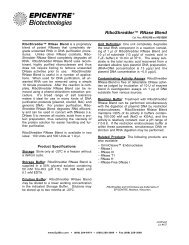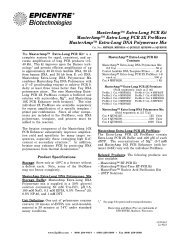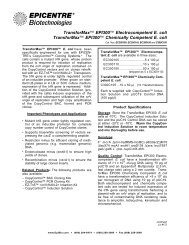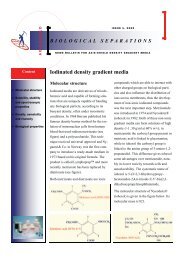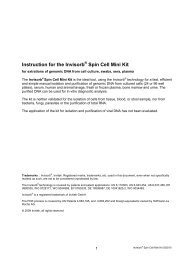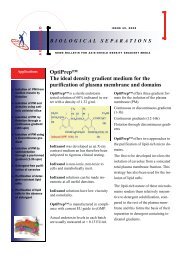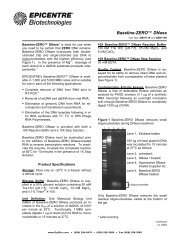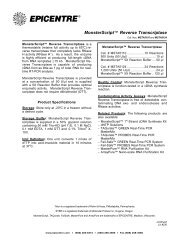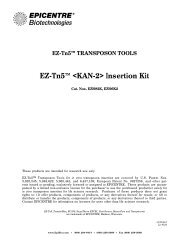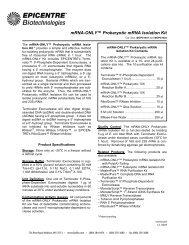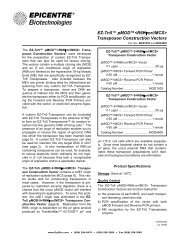RNA Cell HTS 96 Kits
RNA Cell HTS 96 Kits
RNA Cell HTS 96 Kits
- No tags were found...
You also want an ePaper? Increase the reach of your titles
YUMPU automatically turns print PDFs into web optimized ePapers that Google loves.
TroubleshootingProblem Cause Comments and suggestionslittle or no total <strong>RNA</strong>elutedinsufficient disruption orhomogenisationincomplete elutionbuffer temperature too lowunclean working, <strong>RNA</strong> digestioninappropriate sample extractionor storagereduce amount of starting material.Overloading reduces yieldprolong the incubation time with Elution BufferR to 5-10 min or repeat elution step once againall buffers must be at room temperaturethroughout the procedureuse RNase free tubes and pipet tips (seeHandling <strong>RNA</strong> in the Appendix)ensure that sample is flash frozen immediatelyafter extraction; store at –80°Clogged Spin-Filterinsufficient disruption orhomogenizationtoo much starting materialafter lysis spin lysate to pellet debris andcontinue with the protocol using thesupernatant.reduce amount of starting material.degraded <strong>RNA</strong>DNA-contaminationincorrect storage of startingmaterialRNase contaminations ofsolutions, receiver tubes etc.Lysis Solution S does notcontain DTTno optimal homogenization ofDNA binding carriertoo much starting materialelution volume too lowincomplete removal of DNAbinding carrierno DNase treatmentensure that the starting material is frozenimmediately in liquid N 2 and is storedcontinuously at –80°Cavoid thawing of the material; ensure that theprotocol, especially the first steps, has beenperformed quickly.use sterile, RNase-free filter-tips, before everypreparation clean up the pipettes, the devicesand the working place; always wear glovesensure that DTT has been added to the LysisSolution Sshake carefully Lysis Solution before usereduce amount of starting material.DNase digestion of the eluate containing thetotal <strong>RNA</strong>use elution volumes of 60 – 80 µl, repeat elutionstepfollow exactly the protocol and ensure theremoval of the DNA binding carrierif necessary after the InviTrap <strong>RNA</strong> ® <strong>96</strong>procedure, DNase digestion of the eluatecontaining the total <strong>RNA</strong>. After inactivatingDNase by heat treatment, the <strong>RNA</strong> can beeither used directly in the subsequentapplication without further treatment, orrepurified using the <strong>RNA</strong> cleanup protocollow A 260/A 280 value improper pH use 10 mM Tris-Cl, not RNase-free water, todilute the sample before measuring the puritylow well-to-wellreproducibilityelution volume too lowvacuum pressure too lowinhomogeneous cell growthuse elution volumes of 60 – 80 µl, repeat elutionstep (see protocols)a vacuum source capable of generating avacuum pressure of 200 mbar is necessary toachieve efficient <strong>RNA</strong> binding to the membrane,washing, and elution when using vacuum orvacuum/ spin technologyensure, that cells grow equably20 InviTrap ® <strong>RNA</strong> <strong>Cell</strong> <strong>HTS</strong> <strong>96</strong> Kit/ C and V 0810




